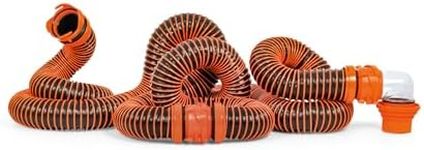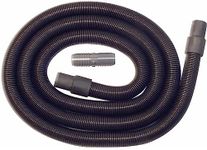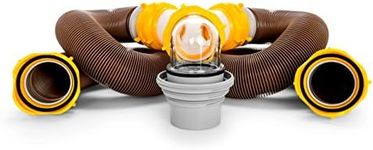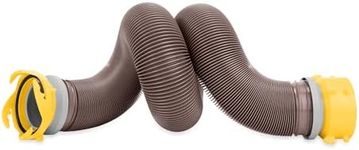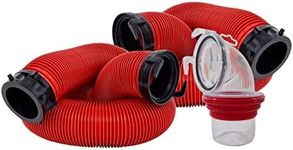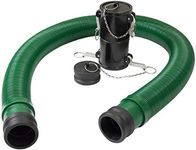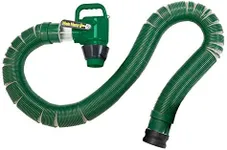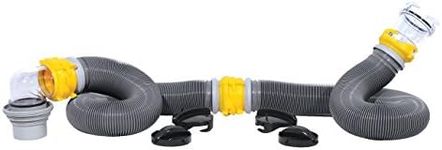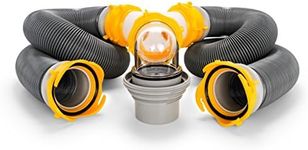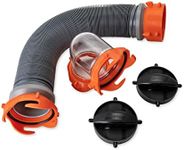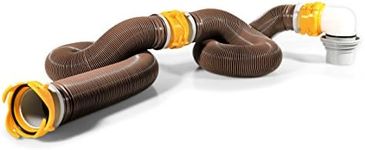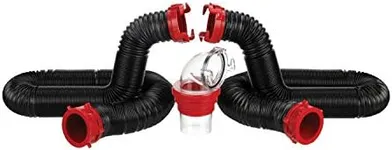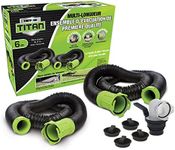Buying Guide for the Best RV Sewer Hoses
Choosing the right RV sewer hose is essential for a hassle-free and sanitary experience when emptying your RV’s waste tanks. The right hose will make the process cleaner, easier, and more reliable, helping you avoid leaks, spills, and unpleasant surprises. When shopping for an RV sewer hose, it’s important to consider a few key features that affect durability, ease of use, and compatibility with your RV setup. Understanding these features will help you select a hose that matches your travel habits and the environments you’ll encounter.LengthLength refers to how long the sewer hose is when fully extended. This is important because you need enough hose to comfortably reach from your RV’s waste outlet to the dump station connection, which can vary in distance. Hoses typically come in lengths ranging from 10 to 20 feet, with some models allowing you to connect multiple hoses for extra reach. If you usually camp at sites with close dump stations, a shorter hose may be sufficient and easier to store. If you visit a variety of campgrounds or want extra flexibility, a longer hose or the ability to extend your hose is a good idea.
DiameterDiameter is the width of the hose opening, usually measured in inches. Most RV sewer hoses have a standard diameter of 3 inches, which fits most RV waste outlets and dump station inlets. This size allows for efficient flow and helps prevent clogs. It’s important to make sure the hose you choose matches the fittings on your RV and the dump stations you’ll use. If you have a unique setup, double-check compatibility, but for most users, the standard diameter is the best choice.
Material and DurabilityThe material and durability of the hose determine how well it stands up to repeated use, exposure to the elements, and rough handling. Hoses are typically made from heavy-duty vinyl or reinforced plastic, with some offering extra-thick walls or UV protection. A more durable hose will resist punctures, crushing, and cracking, which is especially important if you travel frequently or camp in areas with rough terrain. If you only use your RV occasionally, a basic hose may suffice, but for regular travelers, investing in a sturdier hose can save you trouble in the long run.
Flexibility and CollapsibilityFlexibility refers to how easily the hose bends and moves, while collapsibility is about how compactly it can be stored when not in use. A flexible hose is easier to maneuver around obstacles and connect to dump stations, while a collapsible hose saves valuable storage space in your RV. If you have limited storage or need to navigate tight spaces, look for a hose that is both flexible and collapsible. If storage space is not a concern, you may prioritize other features.
Fittings and ConnectionsFittings and connections are the end pieces that attach the hose to your RV and the dump station. Quality fittings ensure a secure, leak-free connection and often include features like swivel ends for easier attachment or clear elbows to monitor flow. Some hoses come with pre-attached fittings, while others require you to add your own. If you want a quick and easy setup, look for hoses with pre-installed, universal fittings. If you have specific needs or want to customize your setup, check compatibility with your existing equipment.
Ease of CleaningEase of cleaning refers to how simple it is to rinse out and maintain the hose after use. Some hoses have smooth interiors that resist buildup and are easier to flush clean, while others may have ridges that can trap waste. A hose that is easy to clean will help prevent odors and prolong the life of the hose. If you value convenience and hygiene, look for hoses designed for easy rinsing and consider accessories like hose supports or dedicated rinse fittings.

